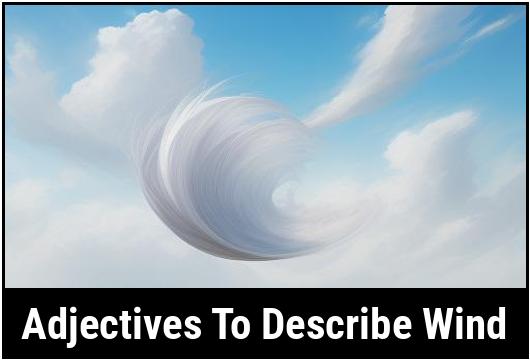- You are here:
- Home »
- adjectives
- » 31 Adjectives To Describe Wind

31 Adjectives To Describe Wind
The wind is an elemental force of nature that has been inspiring awe and wonder in humans for millennia. It can range from a gentle breeze to a powerful gale, shaping the world around us and influencing everything from weather patterns to the way we experience the outdoors. Describing the wind can be a poetic and powerful way to convey the atmosphere and mood of a scene, whether in a literary work or a casual conversation. Using adjectives to describe the wind allows us to paint a vivid picture of its characteristics and the impact it has on our surroundings.
Key Takeaways
- The wind is a dynamic force that can be described using a wide range of adjectives.
- Choosing the right adjective to describe the wind can evoke specific emotions and imagery.
- There are various types of adjectives that can be used to effectively describe the wind, considering its speed, direction, and impact on the environment.
Adjectives To Describe Wind
1. Gentle
When the wind is gentle, it caresses your skin like a soft embrace. It skims across the landscape, barely ruffling the leaves or disturbing the calm. Gentle wind is soothing and peaceful, creating a serene atmosphere that invites relaxation and contemplation.
2. Breezy
A breezy wind is a playful companion, dancing through the air with a sense of lightness. It whispers in your ear and tousles your hair, reminding you of carefree days spent outdoors. With each gust, it brings a refreshing energy that invigorates both body and mind.
3. Mild
Mild wind is like a mild-mannered friend who offers a helping hand without demanding attention. It moves effortlessly, neither too forceful nor too weak, providing a pleasant sensation that goes unnoticed until you pause to appreciate its presence.
4. Whirling
When the wind is whirling, it becomes a spectacle of swirling motion. It twists and turns, creating a mesmerizing display of kinetic energy. Whirling wind can be both captivating and unsettling, evoking a sense of wonder at its unpredictable nature.
5. Rustling
Rustling wind is characterized by the gentle sound it creates as it passes through the leaves of trees or tall grass. It produces a symphony of whispers, adding a melodious backdrop to nature’s chorus. The rustling wind is a reminder of the hidden secrets it carries within its invisible grasp.
6. Brisk
A brisk wind is invigorating, awakening your senses with its energetic presence. It moves purposefully, sweeping away stagnation and encouraging activity. Brisk wind inspires a feeling of motivation and prompts you to embrace the outdoors and seize the day.
7. Zephyr
Zephyr, a term derived from Greek mythology, refers to a soft and gentle wind that is typically associated with the arrival of spring. Zephyrs bring with them a promise of warmer weather and a rejuvenation of the natural world. This delicate breeze holds a touch of magic, breathing new life into everything it touches.
8. Whistling
In the cool autumn air, you may sometimes hear the wind whistling through narrow openings or around corners. This sound, reminiscent of a distant tune, adds a mysterious and enchanting quality to the atmosphere. Whistling wind carries the secrets of forgotten tales and stirs the imagination.
9. Gale-force
Gale-force wind is a force to be reckoned with. It can be both awe-inspiring and overwhelming. With its powerful gusts, gale-force wind can uproot trees, toss objects, and make even the most mundane walk an adventure. The strength of this wind demands respect while reminding us of our vulnerability in the face of nature’s might.
10. Blustery
Blustery wind is characterized by its turbulent nature. It moves in unpredictable bursts, sending leaves swirling and causing an occasional shiver down your spine. Blustery wind elicits a sense of untamed energy, encouraging you to embrace spontaneity and excitement.
11. Sighing
On a calm evening, when the world grows quiet, you may hear the wind gently sighing. It brings with it a hint of melancholy, whispering secrets of forgotten memories. Sighing wind evokes reflection and introspection, beckoning you to pause and listen to the stories it carries.
12. Roaring
When wind reaches its peak ferocity during a storm, it becomes a roaring force of nature. It sweeps across the land, howling and raging with an intensity that commands attention. Roaring wind makes its presence known with thunderous echoes that declares its dominance over all in its path.
13. Tumultuous
Tumultuous wind is turbulent, chaotic, and wild. It creates a sense of unrest and unease, swirling with an unpredictable intensity. Tumultuous wind may carry both excitement and danger, reminding us of the untamed power of nature that can both captivate and challenge.
14. Gusty
Gusty wind is characterized by its sudden and forceful bursts. It can catch you off guard, making your hair fly and tugging at your clothes. Gusty wind adds an element of surprise to the atmosphere, keeping you on your toes and reminding you of the unpredictable nature of life itself.
15. Playful
When wind takes on a playful nature, it dances and cavorts in the open space. It teases and twirls, creating a sense of joy and whimsy. Playful wind adds a sprightly touch to the environment, encouraging laughter and light-heartedness.
16. Serene
Serene wind is a calming presence that envelops you in tranquility. It hushes the world around you, allowing for moments of peace and restoration. Serene wind whispers gentle lullabies, inviting you to release your worries and embrace a sense of inner serenity.
17. Ruffling
Ruffling wind tousles your hair and stirs a feeling of invigoration. It is a mischievous companion, teasing and disrupting with its gentle touch. Ruffling wind adds a touch of excitement and novelty to your surroundings, reminding you to embrace the unexpected.
18. Stormy
Stormy wind is a force of nature, a harbinger of dramatic change. It accompanies tempestuous skies and crashing thunder, intensifying the atmosphere. Stormy wind carries a sense of urgency and drama, reminding us that even in chaos, there is beauty and potential for growth.
19. Blowing
Blowing wind symbolizes the inherent movement and continuity of life. It blows with unwavering purpose, never ceasing, and brimming with untapped energy. Blowing wind is a reminder of the constant motion that propels the world forward.
20. Whispering
Whispering wind is a gentle confidant that carries secrets in its breath. It murmurs tales of faraway lands and forgotten dreams, inviting you to listen and discover hidden truths. Whispering wind creates an intimate connection with nature, coaxing you to tune in to its soft melodies.
21. Lashing
Lashing wind possesses a fierce and aggressive character that cannot be ignored. It strikes with intensity, leaving a lasting impact. Lashing wind reminds us of the destructive potential that lies within nature, urging us to respect its power and be prepared for its consequences.
22. Sailing
Sailing wind is a sailor’s delight, filling their sails and propelling them forward with ease. It carries the promise of distant lands and the excitement of exploration. Sailing wind evokes a sense of freedom and adventure and showcases the harmonious relationship between humans and the elements.
23. Cooling
On a sweltering summer day, a cooling wind can be a blissful relief. It sweeps away the oppressive heat, bringing a refreshing respite. Cooling wind creates a sense of rejuvenation, invigorating both body and spirit.
24. Rushing
Rushing wind barrels through the landscape, creating a sense of urgency and motion. It whooshes past with a distinct sound, reminding us of the speed and energy that exists in the natural world. Rushing wind portrays a vibrant and lively atmosphere.
25. Energetic
Energetic wind carries with it a contagious vitality that charges the air. It uplifts and invigorates, filling you with a sense of renewed energy. Energetic wind sparks motivation and inspires action, reminding you of the infinite potential that lies within.
26. Crisp
Crisp wind is a characteristic of a clear and cool day. It carries a refreshing chill, bracing your senses and awakening a feeling of aliveness. Crisp wind sharpens your focus, calming your mind and allowing you to fully experience the world around you.
27. Invigorating
Invigorating wind breathes life into stagnant situations, revitalizing and inspiring change. Its touch brings renewed enthusiasm and sparks creativity. Invigorating wind awakens dormant potential, encouraging you to step outside your comfort zone and embrace new possibilities.
28. Rushed
Rushed wind moves with urgency, as if carrying the weight of time itself. It sweeps through with a sense of haste, propelling everything forward. Rushed wind conveys a feeling of momentum and reminds us of the ceaseless passage of time.
29. Spiraling
Spiraling wind twirls and twists, creating spiraling patterns in the air. It adds a whimsical touch to the atmosphere, inviting you to join in its playful dance. Spiraling wind evokes a sense of wonder and serves as a reminder of the beauty and harmony of nature.
30. Sweeping
Sweeping wind moves across the landscape with purpose and determination, leaving no stone unturned. It clears away debris and stagnant energy, making way for fresh beginnings. Sweeping wind symbolizes change and the cyclical nature of life.
31. Harmonious
When wind is harmonious, it acts as a conductor bringing together the different elements of nature. It creates symphonies of movement, blending seamlessly with the world around it. Harmonious wind reminds us of the interconnectedness of all things and the beauty that arises when unity is achieved.
Why Use Adjectives To Describe Wind
The wind is a dynamic and ever-changing natural phenomenon, and using adjectives to describe it allows us to capture its complexity and impact. Adjectives provide a means to convey the characteristics and qualities of the wind in a descriptive and engaging manner. In literature, poetry, and everyday language, adjectives play a crucial role in creating vivid imagery and sensory experiences. When describing the wind, adjectives can evoke a range of emotions, from tranquility to unease, and can transport the reader or listener to the setting being described.
Adjectives also serve to enhance the specificity and precision of our descriptions. By using adjectives to describe the wind, we can communicate its speed, strength, direction, and effects on the environment with greater clarity and detail. This can be particularly important in contexts such as weather reports, storytelling, and environmental writing, where conveying the nuances of the wind’s behavior is essential.
How To Choose The Right Adjective To Describe Wind
When selecting adjectives to describe the wind, it is important to consider the specific qualities and effects of the wind in question. Factors such as its speed, direction, temperature, and impact on the surroundings all play a role in determining the most suitable adjectives. Additionally, the emotional and sensory experience that the wind evokes should also be taken into account. Here are some key considerations for choosing the right adjectives to describe the wind:
-
Observation: Take note of the wind’s behavior and its impact on the environment. Consider its strength, consistency, and any distinctive characteristics such as howling, swirling, or gusting.
-
Emotional Impact: Reflect on the emotions and sensations that the wind elicits. Does it convey a sense of calm and serenity, or does it evoke feelings of unease and foreboding?
-
Sensory Experience: Think about the sensory experiences associated with the wind. Does it feel soft and caressing, or does it have a biting, harsh quality?
-
Context: Consider the context in which the wind is being described. Is it part of a natural landscape, a weather report, or a narrative setting? The context can influence the choice of adjectives to best capture the essence of the wind.
By taking these factors into consideration, you can select adjectives that effectively convey the unique character and impact of the wind in a given situation.
Types Of Adjectives For Describing Wind
Adjectives used to describe the wind can encompass a wide range of qualities, ranging from its speed and direction to its visual, auditory, and tactile effects. Understanding the different types of adjectives that can be used to describe the wind allows for greater precision and richness in communication. Here are several categories of adjectives commonly used to describe the wind:
1. Speed And Intensity
- Gentle: Describes a soft, mild, and soothing wind that creates a tranquil atmosphere.
- Brisk: Indicates a moderately strong and invigorating wind that is refreshing but not overpowering.
- Blustery: Conveys a turbulent and gusty wind with sudden, strong bursts of force.
2. Direction
- Northerly: Indicates that the wind is coming from the north.
- Spiraling: Describes a twisting or swirling wind that moves in a circular or spiral pattern.
- Headwind: Refers to wind that is blowing directly against the direction of movement, creating resistance.
3. Sound And Texture
- Whispering: Suggests a soft, rustling sound associated with a light and gentle breeze.
- Howling: Conveys a strong and mournful sound, often associated with a powerful and intense wind.
- Rustling: Describes the gentle, swishing sound of leaves or grass being moved by the wind.
4. Temperature
- Chill: Indicates a cold and biting quality in the wind, often conveying a sense of discomfort.
- Balmy: Describes a pleasantly warm and soothing wind that imparts a sense of relaxation.
5. Impact And Effect
- Forceful: Conveys a strong and powerful wind that exerts notable pressure on the environment.
- Calming: Suggests a wind that has a soothing and tranquil effect, promoting a sense of peace and serenity.
By using adjectives from these categories, one can effectively capture the diverse characteristics and effects of the wind, providing a nuanced and evocative description.
Describing the wind with adjectives allows us to convey its diverse qualities, ranging from its speed and direction to its sensory and emotional impact. By choosing the right adjectives, we can create vivid and immersive depictions of the wind, enriching our communication and enhancing the sensory experience for our audience. Whether in creative writing, scientific observation, or casual conversation, the use of adjectives to describe the wind adds depth and resonance to our descriptions, allowing us to capture the essence of this elemental force with precision and evocative imagery.
Examples Of Adjectives For Different Types Of Wind
Describing the wind can be a challenging task as it is a dynamic and ever-changing force of nature. However, with the use of adjectives, we can paint a vivid picture and evoke emotions associated with the different types of wind. Adjectives provide depth and detail to our descriptions, enabling us to convey the power, speed, direction, and characteristics of the wind.
- Gentle: A gentle wind is soothing and calm. It caresses the skin with a soft touch, making it perfect for relaxing outdoor activities like a picnic or reading a book by the beach.
Example: "The gentle breeze rustled the leaves of the trees, creating a peaceful atmosphere in the park."
- Brisk: A brisk wind has a moderate speed that adds energy and freshness to the surroundings. It is invigorating and can make one feel alive and recharged.
Example: "The brisk wind swept through the city, causing the colorful flags to flutter vigorously and giving a sense of vitality to the streets."
- Strong: A strong wind is forceful and powerful. It can have a dramatic impact on objects, causing them to move or even be blown away. This type of wind can be both thrilling and a bit intimidating.
Example: "The strong wind howled through the night, rattling the windows and making the branches of the trees bend and sway."
- Gale-force: A gale-force wind is an extremely strong wind, often associated with storms or hurricanes. It can be dangerous and destructive, causing damage to buildings, uprooting trees, and creating chaos.
Example: "The gale-force wind whipped up gigantic waves, crashing against the rocky cliffs with an incredible force, sending sprays of salty water high into the air."
- Fierce: A fierce wind is characterized by its intensity and ferocity. It blows with great strength, creating a sense of urgency and unpredictability.
Example: "The fierce wind tore through the open fields, carrying with it a swirl of dust and debris, making it difficult for anyone to stand upright."
- Whirling: A whirling wind moves in a circular motion, creating a vortex effect. It can be mesmerizing to watch, but also disorienting and turbulent.
Example: "The whirling wind lifted the dry leaves off the ground, spiraling them into a dance in the air, before gently releasing them back to the earth."
- Chilly: A chilly wind carries a cold temperature, causing a sharp sensation and making one shiver. It is often associated with winter or cold climates.
Example: "The chilly wind nipped at their faces and penetrated through their layers of clothing, reminding them to bundle up tightly against the winter cold."
- Biting: A biting wind is extremely cold and has a sharp edge to it. It can feel like pins and needles against the skin, causing discomfort and sometimes pain.
Example: "The biting wind cut through the thin fabric of their jackets, sending shivers down their spines and urging them to seek shelter from the freezing temperatures."
- Searing: A searing wind carries intense heat. It can be oppressive and uncomfortable, often associated with desert regions or scorching summer days.
Example: "The searing wind sucked the moisture out of their bodies, leaving their skin dry and parched, as they sought shelter under the shade to escape the blistering heat."
- Whistling: A whistling wind produces a high-pitched sound as it passes through narrow openings or gaps, such as cracks in the windows or spaces between buildings. It can be eerie or haunting.
Example: "The whistling wind echoed through the abandoned house, creating an atmosphere of mystery and sending a chill down their spines."
Common Mistakes In Using Adjectives To Describe Wind
When using adjectives to describe the wind, it is essential to be mindful of some common mistakes to ensure accurate and effective descriptions. Here are a few common mistakes to avoid:
- Overusing generic adjectives: Using generic adjectives like "strong" or "gentle" repeatedly can make your writing monotonous. Instead, try to explore more specific adjectives that capture the unique qualities and characteristics of the wind.
Incorrect example: "The strong wind blew through the trees and made them sway."
Correct example: "The ferocious wind roared through the dense forest, bending the tall trees like fragile twigs."
- Using inappropriate adjectives: Some adjectives may not be suitable for describing wind or may convey the wrong impression. Make sure the adjectives you use accurately reflect the properties and effects of the wind.
Incorrect example: "The wind was delicious."
Correct example: "The wind carried the sweet fragrance of wildflowers, filling the air with a delightful aroma."
- Neglecting sensory adjectives: Describing wind solely in terms of its strength or speed can be limiting. Including sensory adjectives that evoke the five senses can make your descriptions more immersive and engaging.
Incorrect example: "The wind blew strongly."
Correct example: "The wind howled through the narrow alley, its icy fingers scraping against his cheeks, while the deafening sound drowned out his thoughts."
- Lack of contextualization: Describing the wind without providing a context or setting can lead to vague and disconnected descriptions. Consider the environment, time of day, and other elements that can influence and shape the perception of the wind.
Incorrect example: "The wind was cold."
Correct example: "The biting wind cut through the night, turning the moonlit landscape into a frozen wonderland."
Using Adjectives Effectively
To effectively use adjectives to describe the wind, follow these tips:
-
Be specific: Try to use adjectives that vividly capture the unique characteristics of the wind you want to describe. Consider its speed, direction, intensity, sound, temperature, and how it interacts with the environment.
-
Use sensory language: Incorporate sensory adjectives and descriptive words that engage the five senses. This will bring life to your descriptions and make them more realistic and immersive.
-
Create imagery: Utilize figurative language and metaphors to create striking imagery. This can help readers visualize and connect with the descriptions on a deeper level.
-
Vary your vocabulary: Avoid repetitiveness by exploring a wide range of adjectives. This will add richness and variety to your writing, making it more engaging and enjoyable to read.
-
Consider the context: Think about the setting, time, and atmosphere in which the wind is occurring. Take into account the impact of the wind on the surroundings and the feelings it evokes in people.
Exercises And Practice
Now, let’s practice using adjectives to describe the wind. Study each scenario and come up with an appropriate adjective to describe the wind in each case.
-
A wind blowing through a forest in the autumn, causing the colorful leaves to flutter.
-
A wind whipping through an open field during a thunderstorm.
-
A gentle breeze coming from the ocean, carrying the scent of saltwater.
-
A wind blowing across a snowy landscape, making the snowflakes swirl in the air.
-
A wind carrying the fragrance of blooming flowers during a warm spring day.
-
A strong wind sweeping through a bustling city, causing papers to fly and umbrellas to turn inside out.
-
A wind whistling through the narrow streets of an old town, creating an eerie atmosphere.
-
A searing wind blowing across a desert, causing the sand to shift and creating a mirage effect.
-
A biting wind that chills your bones during a winter storm, making it hard to walk against its force.
-
A gusty wind that fills the sails of a sailboat, propelling it through the water with great speed.
Conclusion
Describing the wind effectively requires the thoughtful and creative use of adjectives. By choosing adjectives that accurately reflect the qualities of the wind, considering sensory language, creating vivid imagery, and avoiding common mistakes, you can transport your readers into the experience of feeling and witnessing different types of wind. So, next time you find yourself trying to describe the wind, remember to choose your adjectives wisely and create a captivating and immersive experience for your readers.
FAQS On Adjectives To Describe Wind
What Are Some Adjectives That Can Be Used To Describe Wind?
Wind can be described as variable, strong, gentle, gusty, and turbulent.
What Does It Mean When Wind Is Described As Variable?
When wind is described as variable, it means that it changes in speed and direction frequently and unpredictably.
Can You Give Examples Of Adjectives To Describe Strong Wind?
Some examples of adjectives to describe strong wind are powerful, forceful, fierce, and intense.
How Can Wind Be Described As Gentle?
Wind can be described as gentle when it is light, soft, and soothing. It may also be described as a gentle breeze or a light wind.
What Is Meant By Gusty Wind?
Gusty wind is characterized by sudden, short bursts of strong wind. It can be unpredictable and may cause objects to move or sway abruptly. Some adjectives to describe gusty wind are turbulent, erratic, and blustery.








